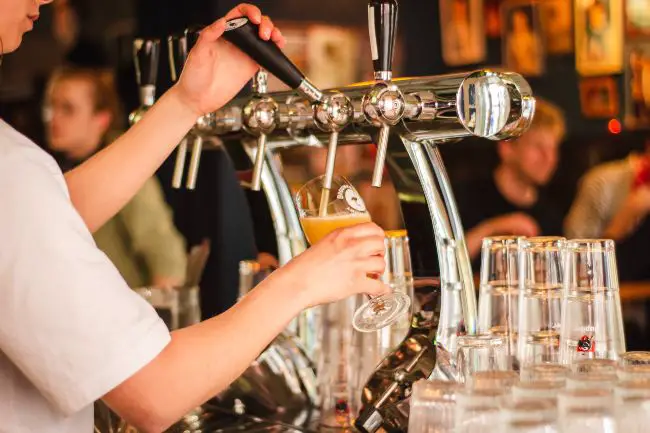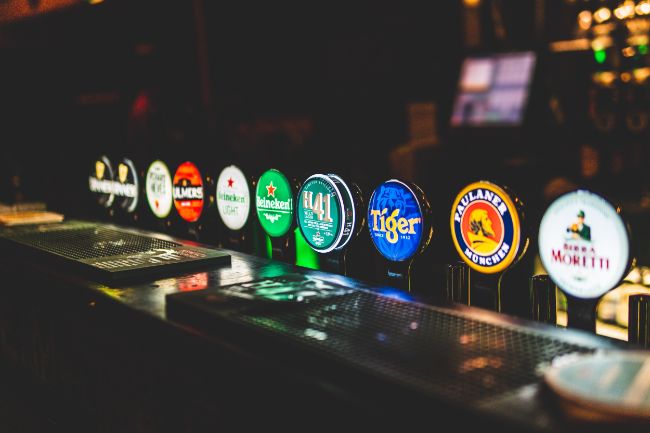You must have heard about bottled and draft beers if you’re new to the beer industry.
Questions like “What is draft beer?” have raced through your head.
You may have also heard of “draft vs. bottle beer” debates.
Continue reading, as this article contains the answers to these inquiries.

What is Draft Beer?
What are draft beers?
Draft beers are served straight from a cask or keg instead of in a bottle or can.
Draft beer is regarded to be better than most other beers since light and oxygen can’t get into the keg.
Before 1785, when the beer engine was invented, beer was transported and served right out of the barrel.
The word “draught” came from the Old English word “dragan,” which means “to carry or pull.”
Today, it is spelled “draught” in the UK, Ireland, Australia, and New Zealand, but “draft” in North America.
Draft vs. Bottle Beer
There is no such thing as an identical beer.
Even though they all have different alcohol content, many beer brands taste different, mainly because of how they are served.
There are two primary beer varieties: draft beer and bottled beer.
Both bottled and draft beer are made the same way.
The only difference is one beer in a keg or cask instead of a bottle.
However, a second fermentation happens when the beer goes into the cask.
Draft beers are alcoholic beers served from a tap into a glass.
Conversely, bottled beers are sold or consumed in bottles.
Their consumption significantly affects their taste and how long they last.
Sunlight affects bottled beer, making it unstable.
Ultraviolet rays from the sun can quickly get through their clear bottles, damaging the beer or making it “lightstruck,” as some people call it.
This isn’t a big problem with draft beers because the barrels or kegs protect them from light.
When making beer drinks, you should also think about hygiene.
When it comes to bottled beers, they almost always ensure the bottles are clean and of good quality.
Inadequate maintenance and unhygienic standards can allow germs and mold to grow in draft beer lines and pipelines, altering the taste and smell.
These two types of beer taste and smell differently.
Draft beers are more full of flavor than bottled beers.
The beer in the glass sits there for a while, letting the aroma linger.
Bottled beers can look like draft beers when poured into a glass before drinking.
Lastly, when it comes to portability, it’s clear that bottled beers are more portable than draft beers.
Draft beers aren’t supposed to be transported because they are difficult to transport and store in large kegs.
Draft Beer vs. Tap

Usually, draft beer is the same as tap, but one potential difference is that some canned beers claim to be draft beer.
These canned “drafted” beers are still just the same domestic beer.
This is because the draft does not survive long unless adequately stored, especially if hit by light.
Think of canned “drafted” beers as a misnomer used as a clever marketing tactic.
One example is when Miller made Miller Genuine Draft, a pale lager produced with a cold-filtration system.
There is also Guinness stout in cans and bottles with draught flow.
This smooth beer is made with a nitrogen widget.
Tap beers are beer in a keg; they come right out of the tap.
You can apply pressure to the tap or pump it by hand.
Keg beer is better than other beers for a lot of reasons.
First, the keg prevents light from weakening the beer.
It also keeps oxygen from getting into the beer, which keeps it fresher for longer.
You might also ask, “How much do kegs weigh?“
Lastly, this beer is more quickly consumed than the rest; it stays fresh and stored for a shorter time.
Final Thoughts
Draft beer has a better taste and experience when drunk, while canned beers are more convenient and accessible.
Also, remember that if you wish to experience draft beer, you must check the pub you are drinking at.
A poorly managed establishment can lead to bad tastes and a poor experience.
Conversely, an excellent establishment can give you the best beer experience you have ever had.